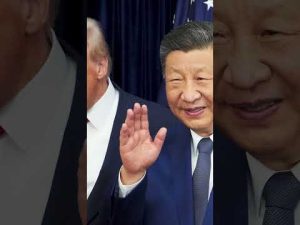In the tangled web of international trade and dizzying economic strategies, the recent discussions surrounding the U.S.-China trade agreement seem to have snagged the spotlight. It’s hard not to notice the sheer brilliance of President Trump’s strategy of putting himself in the middle of high-stakes negotiations, a move that seems to have left China with their pockets lighter, all while keeping American soybean farmers breathing easier. The tariffs remain sky-high, as if giving everyone involved a stern reminder that this is not just a friendly game of chess—it’s an economic battleground.
And speaking of brilliant maneuvers, it appears the U.S. economy is weaving an interesting story all of its own. Stock markets are reaching new heights, giving investors something to cheer about, or perhaps worry about depending on who you ask. The economy is experiencing what some would call a “sugar high,” raising questions about its sustainability. Still, the undeniable boom in job creation and rising wages provide a solid narrative that Americans, especially those at the lower end of the pay scale, are enjoying this moment in the sun. Consumer confidence is soaring, with folks spending money like they’ve just discovered the true meaning of retail therapy.
Of course, not all the news is sunshine and blue skies. The government shutdown saga continues to unfold, with its lengthy grip starting to leave a mark on the nation’s economic pulse. This situation has Democrats and Republicans in a high-stakes staring contest, with real-world impacts on 750,000 government workers who might just wish they’d blink already. The current quarrel is putting a dent in GDP, effectively slowing down momentum, much like an abrupt pothole on an otherwise smooth highway. As the longest shutdown looms closer, one might wonder if Congress has confused “holdout” for “hold up,” and forgot whose lives hang in the balance.
To add to the mix, Jerome Powell, head of the Federal Reserve, seems to have taken a page out of an unpredictable novel. His statements about economic fog and interest rate cuts read like an intriguing mystery. Powell, without his fog lights, leaves some questions hanging in suspense. Rates cut here, uncertain forecasts there; it’s like watching a magician perform a trick where the rabbit seemingly slips up its own sleeve instead of out of a hat. Critics might suggest the Fed has taken on a part-time role as a partisan entity, swaying like leaves in the political wind.
On the northern front, there’s talk about diplomatic dance sessions with Canada, where navigating trade deals is proving trickier than expected. Canada’s government, quite reminiscent of Democratic ideals back home, seems reluctant to tango to the same beat. It’s understandable that some of these negotiations feel more like a playoff series—tense, competitive, and requiring immense strategy. One might note that while they discuss border treaties, others wax lyrical about Toronto’s near-victory in the World Series, trying to bridge gaps with a dash of sportsmanship and neighborly respect. In the end, all these discussions and decisions impact more than just trade numbers—they shape the everyday American experience.







